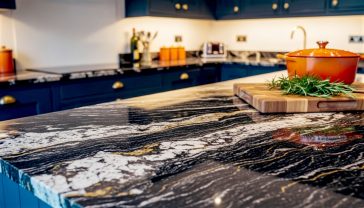5 Questions You MUST Ask Your Worktop Supplier Before Paying a Deposit
Choosing a kitchen worktop is a huge investment. Here are the five non-negotiable questions you must ask your supplier before paying a deposit to guarantee a perfect fit.

This post may contain affiliate links. If you make a purchase through these links, we may earn a commission at no additional cost to you.
So, you’re finally doing it. After months of scrolling through Pinterest, collecting samples, and dreaming of the perfect kitchen, you’re ready to choose the crowning glory: your new worktop. It’s the surface where you’ll roll out pastry, chop vegetables for a Sunday roast, and rest a well-deserved cuppa. It’s a huge part of your kitchen’s look and a massive chunk of the budget.
You’ve found a supplier. Their showroom is lovely, the samples look fantastic, and the salesperson is friendly. They’ve drawn up a quote, and all that’s left to do is pay the deposit to get the ball rolling.
Stop. Right. There.
Handing over that deposit is the point of no return. It’s the moment you commit, locking you into a contract with a company you’re trusting to measure, cut, and fit a very large, very expensive, and very heavy piece of material into the heart of your home. Get it right, and you’ll smile every time you walk into your kitchen. Get it wrong, and you could be facing months of stress, hidden costs, and a finish that makes you wince.
A good, trustworthy supplier will have nothing to hide. They’ll welcome your questions and have clear, confident answers. A dodgy one will get flustered, be vague, or try to rush you. Think of these five questions as your essential pre-flight checklist. They are your shield against cowboy fitters and your key to getting the beautiful, durable worktop you’ve been dreaming of, without any nasty surprises.
Let’s dive in.
Question 1: “Can I Have a Fully Itemised Quote, Including Everything from Templating to Final Sealant?”
This isn’t just the most important question; it’s the only way to compare quotes fairly and avoid the dreaded disease of ‘hidden cost creep’.
You see, some suppliers use a tactic that’s a bit like a budget airline ticket. The headline price for your chosen quartz looks brilliant, an absolute steal! But once you’ve committed, you find out that price didn’t include the baggage (delivery), the seat selection (a hob cut-out), or even the tax (VAT). Suddenly, your bargain isn’t a bargain at all.
A vague quote that just says “Supply and fit quartz worktop: £3,000” is a massive red flag. It’s a blank cheque you’re handing over, and the supplier can fill in the gaps later – almost always in their favour.
Why This Is So Important
A worktop isn’t just a slab of stone. It’s a whole service. You’re paying for the material, the expert’s time to create a perfect template, the use of hugely expensive machinery to cut it, the skilled team to transport and install it, and all the little bits and bobs that make for a perfect finish. Each of these things costs money. A professional company knows these costs and should be transparent about them.
An itemised quote shows you they are organised and honest. It proves they’ve thought carefully about your specific job, rather than just plucking a figure out of the air.
What a Good Quote Looks Like
Your quote should be a detailed list. You’re looking for separate line items for every single component of the job. It should feel less like a single price and more like a recipe for your new kitchen surface.
Your itemised quote MUST include:
- Material: The name of the material (e.g., ‘Carrara Quartz’ or ‘Star Galaxy Granite’), the thickness (usually 20mm or 30mm), and the total square meterage.
- Templating: The cost for a specialist to visit your home and create a precise digital or hardboard template.
- Fabrication: This is the factory work – the cutting and polishing of the stone.
- Delivery: The charge for getting the very heavy, very fragile worktop from their workshop to your home.
- Installation: The cost for the fitting team’s labour.
- Cut-outs (Polished): A separate price for EACH cut-out. This includes your sink (specify if it’s an undermount or inset sink, as this changes the work), your hob, and any pop-up sockets.
- Tap Holes: Yes, even the small hole for the tap.
- Drainer Grooves: If you’re having grooves cut into the stone next to your sink.
- Edge Profile: The cost for finishing the edges. A simple bevelled edge might be standard, but a more decorative Ogee or Bullnose edge will likely cost more.
- Upstands or Splashbacks: If you’ve ordered matching stone to run up the wall.
- Any other features: This could be a window sill or a waterfall end (where the worktop continues down the side of a cabinet).
- Sealing: For natural stone like granite or marble, this is a crucial step.
- VAT: It must be clearly stated whether the prices include or exclude VAT.
When you have quotes broken down like this, you can compare apples with apples. You might see that one supplier seems cheaper on the material but is charging a fortune for the cut-outs. Another might have a higher material cost but includes everything else in a bundle. You can only know this if you see it all written down.
The bottom line: If a company refuses to itemise their quote or gets defensive when you ask, walk away. A professional has nothing to hide.
Question 2: “What is Your Templating and Installation Process, and Who is Responsible for What?”

Imagine this: the fitters arrive with your beautiful new worktop. They go to lift it into place, and… it doesn’t fit. The wall is wonky. The new kitchen units aren’t quite level. They tell you it’s your fault and they’ll have to take it back to the workshop to be re-cut, which will cost you an extra £300 and delay things by two weeks. A nightmare.
This is what a clear process is designed to avoid. Understanding the timeline and the responsibilities – both yours and the supplier’s – is crucial for a smooth, stress-free installation. It’s all about managing expectations.
Why This Is So Important
Fitting a worktop is a precise science. We’re talking millimetre accuracy. A tiny mistake at the templating stage can become a huge, ugly gap at the installation stage. You need to know that the people doing the job are pros who have a clear, tried-and-tested system.
You also need to know exactly what you need to have ready for them. The success of the template and installation often depends on the prep work that you, your builder, or your kitchen fitter has done.
What to Ask About the Process
This is a two-part question. First, templating. Second, installation.
For the Templating Visit:
- “Who does the templating?” Are they an in-house expert or a subcontractor? An in-house team is often better as they are fully accountable to the company you’re paying.
- “What needs to be ready before you arrive?” A good supplier will insist on a few things. All base cabinets must be fully installed, fixed in their final position, and perfectly level. The sink and hob should be on-site (even if not plumbed in) so they can take exact measurements from the physical items.
- “Will you be using a digital laser or a physical template?” Both methods are fine, but it shows they have a professional system.
- “Can I confirm all the details with the templater?” You should be present at the templating appointment. This is your last chance to confirm details like the exact position of the tap, the overhang of the breakfast bar, and the corner radius you want. A good templater will run through a detailed checklist with you and get you to sign it off.
For the Installation Day:
- “How long after the template will the installation happen?” This is the lead time. A typical time for stone worktops is 7-10 working days. This is a critical piece of information for planning the rest of your kitchen project.
- “Who are the fitters?” Again, are they an experienced in-house team or subcontractors? In-house teams are generally preferable.
- “What do I need to do to prepare?” Ensure clear access to the kitchen. You might need to arrange for your old worktops to be removed.
- “Do you handle plumbing or electrical work?” The answer is almost always no. Worktop fitters are specialists in stone or wood. They are not qualified plumbers or electricians. This is a vital point. You will need to arrange for a plumber to disconnect your old sink and tap before they arrive, and to reconnect the new ones after they leave. The same goes for your hob. Misunderstanding this can cause major delays.
- “How are the seams (joins) handled?” With a long worktop run, a join is often unavoidable. Ask how they minimise the appearance of the seam. They should use specialist colour-matched epoxy and joining clamps to get a tight, clean finish. Ask to see pictures of their previous seam work.
A good supplier will be able to walk you through this process with confidence. They might even have a printed sheet or a page on their website that explains everything. This is a sign of a company that values clear communication and has done this hundreds of times before. If they are vague or say, “Don’t worry about it, we’ll sort it,” be wary. Details matter.
Question 3: “Where Does This Specific Material Come From, and Can I See the Exact Slab?”
This question is most critical if you are buying a natural material like granite or marble, but it’s still very important for engineered materials like quartz.
Think of a natural stone worktop like a giant, one-of-a-kind painting created by nature over millions of years. A tiny 10cm sample in a showroom is like looking at one square inch of that painting. It might show you the general colours, but it can’t possibly capture the sweeping veins, the unique mineral clusters, or the subtle colour shifts of the entire canvas.
Why This Is So Important (Especially for Natural Stone)
Every single slab of granite, marble, or quartzite is unique. The pattern on the slab they cut for you could be wildly different from the little square you fell in love with. You might have chosen a sample that was mostly calm and grey, but the full slab could have a huge, dramatic rust-coloured vein running right through the middle. If you haven’t seen and approved it beforehand, you have no grounds to complain when it arrives.
For engineered quartz, the process is more consistent, but batch variations can still occur. A slab made in May might have a slightly different shade or a different distribution of speckles compared to a slab made in December. If you are using more than one piece (for example, on an island and a main run), it’s vital they come from the same batch to ensure a perfect match.
What You Should Expect
For Natural Stone (Granite, Marble, Quartzite):
- “Can I visit your stoneyard to view and select my actual slab?” The answer from a good supplier should be an enthusiastic “Yes, of course!” They should be proud to show you their stock.
- Go and see it. It might mean a trip to an industrial estate, but it is 100% worth it. Take your sample with you to compare. Look at the whole slab in natural light if possible. This is your chance to spot any features you love (or hate).
- Reserve your slab. Once you’ve found ‘the one’, the supplier should be able to put your name on it, either with a sticker or a note in their system. This ensures that the beautiful slab you chose is the one that ends up in your kitchen.
For Engineered Stone (Quartz):
- “Which brand is this?” There are premium brands like Silestone, Caesarstone, and Cambria, and there are hundreds of cheaper, unbranded alternatives, often referred to as ‘OEM’ quartz from the Far East. The quality, durability, and warranty can vary hugely. A premium brand will have a rigorous quality control process.
- “Can you guarantee all my pieces will come from the same batch?” This is a simple but crucial question. The answer should be a straight “yes”.
- “Can I see a full slab?” Even with quartz, it’s a good idea. The pattern repeat on some of the marbled designs can be quite large, and seeing a big piece gives you a much better feel for the overall effect than a small sample.
A supplier who is cagey about the origin of their stone or who won’t let you see the exact slab is a major red flag. It suggests they might be cutting corners on quality or that they have something to hide. A proud craftsman is always happy to show you the quality of their materials.
Question 4: “What Warranties Do You Offer on the Material and the Workmanship?”

A warranty isn’t just a piece of paper. It’s a promise. It’s the company’s statement that they stand behind the quality of their product and the skill of their team. In the unlikely event that something goes wrong, it’s your peace of mind and your protection.
But here’s the crucial bit many people miss: there are two different types of warranty you need to ask about.
- The Material Warranty: This comes from the company that manufactured the slab itself.
- The Workmanship Warranty: This comes from the company that templated, cut, and installed your worktop.
They cover completely different things, and you need both.
Why This Is So Important
Imagine that six months after installation, a weird stain appears on your quartz that can’t be removed, or a hairline crack develops from a corner. Or perhaps a year down the line, one of the seams starts to open up. Who is responsible?
If the fault is in the stone itself (a manufacturing defect), that’s covered by the material warranty. If the fault is in the fitting (a badly made join or improper support), that’s covered by the workmanship warranty. Without clear, written warranties, you could end up in a frustrating situation where the installer blames the material manufacturer, and the manufacturer blames the installer, leaving you stuck in the middle.
What to Look For
The Material Warranty:
- This is especially important for branded quartz. Big brands like Silestone often offer warranties of 10, 15, or even 25 years. This covers the slab against manufacturing defects.
- Ask the supplier: “How is the manufacturer’s warranty registered?” Usually, you or the supplier will need to register the installation online with the brand, using serial numbers from the slab. A good supplier will help you with this or do it for you.
- For natural stone, material warranties are rare because it’s a natural product with inherent ‘flaws’ and features. The quality comes from the supplier’s expertise in selecting good slabs.
The Workmanship Warranty:
- This is the supplier’s guarantee on their own work. It should cover things like the quality of the seams, the accuracy of the fitting against the walls, and ensuring the worktop is properly supported and level.
- Ask them: “How long do you guarantee your installation work for, and what does it cover?” A standard workmanship warranty is typically for one year, but some excellent companies offer more.
- Get it in writing. A verbal promise is not a warranty. It should be a clause in their terms and conditions or a separate certificate they give you after the job is complete.
In the UK, you also have statutory rights under the Consumer Rights Act 2015. This means goods should be of satisfactory quality and fit for purpose, and services (like installation) must be carried out with reasonable care and skill. A formal warranty is an extra layer of protection on top of this.
A supplier who is clear and confident about their warranties is a supplier who is confident in their product and their team. If they dismiss the question or say “Oh, you won’t need one,” it suggests a lack of professionalism.
Question 5: “Can I See Examples of Your Recent Work and Speak to a Past Customer?”
In the age of the internet, anyone can build a beautiful website and fill it with glossy, perfect-looking stock photos of kitchens. But those pictures don’t tell you anything about the quality of that specific company’s work. They don’t show you how tidy their fitters were, how they handled a tricky corner, or how happy the customer was at the end of the day.
You need to see real work, for real customers, in real homes. And ideally, you want to hear from one of those customers directly.
Why This Is So Important
This question cuts through all the marketing fluff and gets to the heart of the matter: can they actually do a good job? A company’s past performance is the best indicator of its future performance.
Seeing their portfolio proves they have a track record. Speaking to a customer gives you unfiltered feedback on the whole experience, from the first phone call to the final wipe-down of the new worktop. It’s the ultimate reference check.
What to Look For
- A Portfolio of Real Jobs: Ask to see pictures of their recent installations. Look for high-quality photos, not blurry phone snaps. Do the seams look tight? Are the edges perfectly polished? Do they have experience working with the material you’ve chosen? A good supplier will have a gallery on their website or a social media page (like Instagram) full of their work.
- Verifiable Reviews: Look them up on independent review sites like Google, Trustpilot, or Checkatrade. Don’t just look at the star rating; read the comments. Are they recent? Do they mention the fitters by name? How did the company respond to any negative reviews? A handful of glowing, anonymous reviews is a red flag. A solid history of detailed, genuine-sounding reviews is a great sign.
- A Willingness to Provide a Reference: Ask them: “Would it be possible to speak to one of your customers from a recent local installation?” A great company will have a list of happy customers who have already agreed to act as references. This shows ultimate confidence in their work. A company that refuses, gets defensive, or says they can’t because of ‘data protection’ is likely hiding something. (They can always ask a customer for permission first).
If you do get to speak to a past customer, have a couple of questions ready:
- “How was the communication throughout the process?”
- “Were the templater and fitters professional and tidy?”
- “Were there any unexpected costs or delays?”
- “Are you happy with the final result?”
Hearing a positive “Yes, they were brilliant” from a real person is the most powerful reassurance you can get. It transforms the supplier from a stranger into a trusted professional.
Your Deposit is Your Power
Choosing a worktop is a huge decision, and your deposit is your biggest piece of leverage. Before you hand it over, you are in complete control. Use that power to get the clarity and reassurance you need.
By asking these five simple but powerful questions, you change the dynamic. You are no longer just a ‘punter’; you are an informed, discerning customer who expects high standards.
A great supplier won’t just answer your questions; they’ll be impressed that you asked them. They’ll see you as a serious customer who cares about quality, and they’ll rise to the occasion. And when the fitters finally leave, and you’re standing in your new kitchen, running your hand over that perfectly fitted, beautiful surface, you’ll be so glad you did. You won’t just have bought a worktop; you’ll have bought peace of mind.
Further Reading & Resources
For those looking to dive even deeper, these resources are highly respected within the UK kitchen and stone industry:
- The Stone Federation Great Britain: The official trade association for the natural stone industry, offering technical advice and a directory of member companies.
- Grand Designs Magazine: A fantastic source of inspiration and practical advice for home renovation projects.
- Ideal Home: Offers guides and buyer advice on all aspects of kitchen design.
- Cosentino: The manufacturer of Silestone and Dekton, their website has a wealth of information on engineered stone.
- Caesarstone: Another leading quartz brand with detailed product information and care guides.






